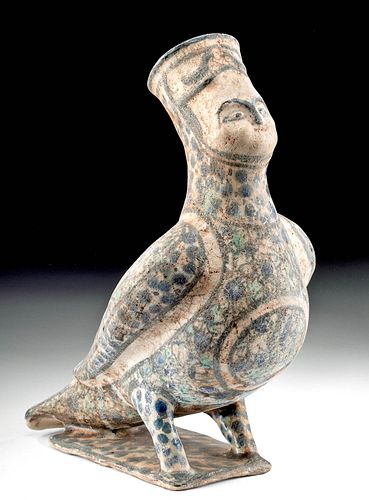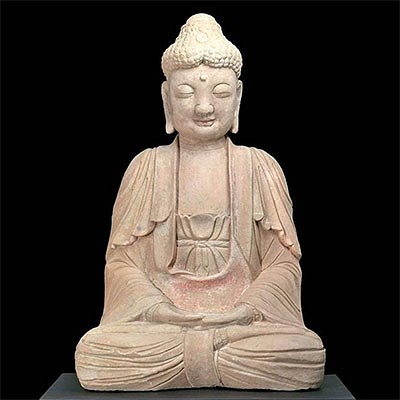13th C. Il-Khanid Polychrome Harpy Vessel
Lot 68a
About Seller
Artemis Gallery
686 S Taylor Ave, Ste 106
Louisville, CO 80027
United States
Selling antiquities, ancient and ethnographic art online since 1993, Artemis Gallery specializes in Classical Antiquities (Egyptian, Greek, Roman, Near Eastern), Asian, Pre-Columbian, African / Tribal / Oceanographic art. Our extensive inventory includes pottery, stone, metal, wood, glass and textil...Read more
Categories
Estimate:
$12,000 - $18,000
Absentee vs Live bid
Two ways to bid:
- Leave a max absentee bid and the platform will bid on your behalf up to your maximum bid during the live auction.
- Bid live during the auction and your bids will be submitted real-time to the auctioneer.
Bid Increments
| Price | Bid Increment |
|---|---|
| $0 | $25 |
| $300 | $50 |
| $1,000 | $100 |
| $2,000 | $250 |
| $5,000 | $500 |
| $10,000 | $1,000 |
| $20,000 | $2,500 |
| $50,000 | $5,000 |
| $100,000 | $10,000 |
| $200,000 | $20,000 |
About Auction
By Artemis Gallery
Feb 18, 2021
Set Reminder
2021-02-18 10:00:00
2021-02-18 10:00:00
America/New_York
Bidsquare
Bidsquare : Exceptional Antiquities, Asian, Ethnographic
https://www.bidsquare.com/auctions/artemis-gallery/exceptional-antiquities-asian-ethnographic-6373
Museum-worthy examples of Egyptian, Greek, Roman, Etruscan, Near Eastern, Far East / Asian, Pre-Columbian, African / Tribal, Oceanic, Native American, Spanish Colonial, Russian, Fossils, Ancient Jewelry, Fine Art, so much more! Artemis Gallery info@artemisgallery.com
Museum-worthy examples of Egyptian, Greek, Roman, Etruscan, Near Eastern, Far East / Asian, Pre-Columbian, African / Tribal, Oceanic, Native American, Spanish Colonial, Russian, Fossils, Ancient Jewelry, Fine Art, so much more! Artemis Gallery info@artemisgallery.com
- Lot Description
Ancient Near East, Il-Khanid period, ca. 1256 to 1353 CE. A magnificent polychrome ceramic vessel in the form of a harpy - a fantastic human-headed bird known from ancient Greece, India, as well as the Middle East that was a popular motif throughout the Muslim world. The harpy is delineated with a finely modeled and painted humanoid face topped by a headdress. Black curvilinear outlines delineate the harpy's wings, face, chest, and headdress; while beautiful circular motifs of cobalt blue and jade green hues detail its plumage. The Il-Khanid harpy was likely drawn from pre-Islamic sources - associated with the Greek harpies thought to be spirits of the wind and to possess generally threatening qualities as well as the Indian Garuda's great intelligence and magical ability to grow quite large or quite small, as well as to appear and disappear. Size: 7.75" L x 5.2" W x 9.55" H (19.7 cm x 13.2 cm x 24.3 cm)
Islamic art flourished under the reign of Il-Khan Mahmud Ghazan (r. 1295–1304). The Persian-Islamic aesthetic also adopted East Asian influences to create a new artistic vocabulary that was admired by many cultures from Anatolia to India. In addition to pottery, jewelry, metalwork, textiles, and illuminated manuscripts evolved greatly along already established lines during th Il-Khanid period.
See a similar harpy vessel, albeit a bit larger, in the collection of the Metropolitan Museum of Art (accession number 57.51.1).
Provenance: private California, USA collection, acquired 1990s to 2000
All items legal to buy/sell under U.S. Statute covering cultural patrimony Code 2600, CHAPTER 14, and are guaranteed to be as described or your money back.
A Certificate of Authenticity will accompany all winning bids.
We ship worldwide and handle all shipping in-house for your convenience.
#155863Expertly repaired and restored from multiple pieces. This piece is almost entirely comprised of original material and original pigment on the exterior aside from one leg and the upper tip of the tail. Repairs are visible, though difficult to see, on interior of neck. Excellent craquelure on surface with light pitting, small chips, nicks, and deposits in lower profile areas.Condition
- Shipping Info
-
All shipping is handled in-house for your convenience. Your invoice from Artemis Gallery will include shipping calculation instructions. If in doubt, please inquire BEFORE bidding for estimated shipping costs for individual items.
-
- Buyer's Premium



 EUR
EUR CAD
CAD AUD
AUD GBP
GBP MXN
MXN HKD
HKD CNY
CNY MYR
MYR SEK
SEK SGD
SGD CHF
CHF THB
THB
















